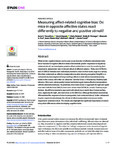Measuring affect-related cognitive bias: Do mice in opposite affective states react differently to negative and positive stimuli?
| dc.contributor.author | Trevarthen, AC | |
| dc.contributor.author | Kappel, Sarah | |
| dc.contributor.author | Roberts, C | |
| dc.contributor.author | Finnegan, EM | |
| dc.contributor.author | Paul, ES | |
| dc.contributor.author | Planas-Sitjà, I | |
| dc.contributor.author | Mendl, MT | |
| dc.contributor.author | ESTEBAN , ARRIBAS REYES | |
| dc.date.accessioned | 2020-07-09T07:53:11Z | |
| dc.date.issued | 2019-12-30 | |
| dc.identifier.issn | 1932-6203 | |
| dc.identifier.issn | 1932-6203 | |
| dc.identifier.other | ARTN e0226438 | |
| dc.identifier.uri | http://hdl.handle.net/10026.1/15878 | |
| dc.description.abstract |
Affect-driven cognitive biases can be used as an indicator of affective (emotional) state. Since humans in negative affective states demonstrate greater responses to negatively-valenced stimuli, we investigated putative affect-related bias in mice by monitoring their response to unexpected, task-irrelevant stimuli of different valence. Thirty-one C57BL/6J and 31 DBA/2J females were individually trained to return to their home-cage in a runway. Mice then underwent an affective manipulation acutely inducing a negative (NegAff) or a comparatively less negative (CompLessNeg) affective state before immediately being tested in the runway with either an ‘attractive’ (familiar food) or ‘threatening’ (flashing light) stimulus. Mice were subsequently trained and tested again (same affective manipulation) with the alternative stimulus. As predicted, mice were slower to approach the light and spent more time with the food. DBA/2J mice were slower than C57BL/6J overall. Contrary to predictions, NegAff mice tended to approach both stimuli more readily than CompLessNeg mice, especially the light, and even more so for DBA/2Js. Although the stimuli successfully differentiated the response of mice to unexpected, task-irrelevant stimuli, further refinement may be required to disentangle the effects of affect manipulation and arousal on the response to valenced stimuli. The results also highlight the significant importance of considering strain differences when developing cognitive tasks. | |
| dc.format.extent | e0226438-e0226438 | |
| dc.format.medium | Electronic-eCollection | |
| dc.language | en | |
| dc.language.iso | en | |
| dc.publisher | Public Library of Science (PLoS) | |
| dc.subject | Affect | |
| dc.subject | Aging | |
| dc.subject | Animals | |
| dc.subject | Bias | |
| dc.subject | Cognition | |
| dc.subject | Female | |
| dc.subject | Humans | |
| dc.subject | Mice | |
| dc.subject | Mice, Inbred C57BL | |
| dc.subject | Mice, Inbred DBA | |
| dc.subject | Models, Animal | |
| dc.title | Measuring affect-related cognitive bias: Do mice in opposite affective states react differently to negative and positive stimuli? | |
| dc.type | journal-article | |
| dc.type | Journal Article | |
| dc.type | Research Support, Non-U.S. Gov't | |
| plymouth.author-url | https://www.webofscience.com/api/gateway?GWVersion=2&SrcApp=PARTNER_APP&SrcAuth=LinksAMR&KeyUT=WOS:000515092200017&DestLinkType=FullRecord&DestApp=ALL_WOS&UsrCustomerID=11bb513d99f797142bcfeffcc58ea008 | |
| plymouth.issue | 12 | |
| plymouth.volume | 14 | |
| plymouth.publication-status | Published online | |
| plymouth.journal | PLOS ONE | |
| dc.identifier.doi | 10.1371/journal.pone.0226438 | |
| plymouth.organisational-group | /Plymouth | |
| plymouth.organisational-group | /Plymouth/Faculty of Science and Engineering | |
| plymouth.organisational-group | /Plymouth/REF 2021 Researchers by UoA | |
| plymouth.organisational-group | /Plymouth/REF 2021 Researchers by UoA/UoA04 Psychology, Psychiatry and Neuroscience | |
| plymouth.organisational-group | /Plymouth/Users by role | |
| plymouth.organisational-group | /Plymouth/Users by role/Academics | |
| dc.publisher.place | United States | |
| dcterms.dateAccepted | 2019-11-26 | |
| dc.rights.embargodate | 2020-7-10 | |
| dc.identifier.eissn | 1932-6203 | |
| dc.rights.embargoperiod | Not known | |
| rioxxterms.versionofrecord | 10.1371/journal.pone.0226438 | |
| rioxxterms.licenseref.uri | http://www.rioxx.net/licenses/all-rights-reserved | |
| rioxxterms.licenseref.startdate | 2019-12-30 | |
| rioxxterms.type | Journal Article/Review |


